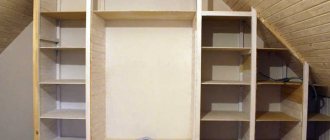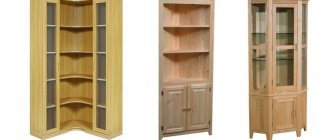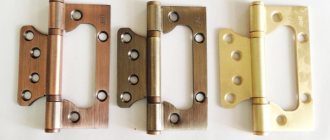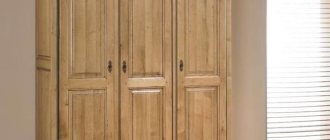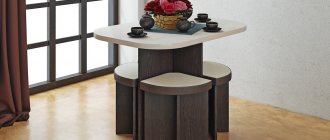Required materials and tools
Initially, you should prepare the materials and tools that will be needed during the installation process. Their number and features may vary depending on the type of fastening mechanism. The most commonly used are four-hinged hinges, which are attached at the top and bottom. At high heights and significant weight, the number of mechanisms increases.
In this matter, the main thing is accuracy and precision, since even a millimeter mistake will ruin the entire impression of the new furniture.
You will need the following tools:
- Self-tapping screws measuring 4 millimeters by 16;
- Roulette or meter tape;
- Hammer;
- Drill;
- Screwdriver;
- Screwdriver;
- Pencil or marker;
- Level and triangle.
The mechanism for fastening the door itself acts as the material. They differ in construction, material, design and function. When choosing hinges, you should base your choice on the size and type of furniture.
Note! When choosing materials, you need to be based on its quality - the service life directly depends on this.
It is best to take fastening devices that have personal quality certificates. This will save you from possible problems, and the furniture will last much longer.
How to install a furniture hinge
Correct placement of doors on furniture ensures long service life and ease of use. From time to time it may happen that the doors are sloping or do not open well. At such moments, the mood deteriorates sharply. That is why it is worth paying much closer attention to the correct installation and design of furniture hinges. Installation must take place in accordance with the rules, because all subsequent use depends on the quality of the installation. Real estate aggregator - Real estate notice board in Kropyvnytskyi
In modern conditions, there are a great many varieties of furniture hinges, each of which is popular with customers in its own way. For example, more modern cabinets use a four-hinged type of hinge. In Europe, such loops are called “hidden”.
Types of fastening devices
Usually, varieties are distinguished based on the method of fastening and application. The most commonly used are four-hinged models, which are simple and convenient to install and operate.
When choosing a furniture set, do not forget that the four-hinged hinges are installed directly on the side walls of the cabinet using self-tapping screws.
In addition to them, the following types can be distinguished:
- Card. This is the oldest and simplest method of fastening, which is currently practically not used. The movement is carried out through a special rod, which expresses the role of a hinge;
- Like a pendulum. Using this design, you can open the door completely 180 degrees;
- "Mezzanine". Allows you to open the door in a horizontal position. Most often used for kitchen cabinets. They operate using springs that prevent the door from opening and closing arbitrarily;
- Ombre. Installed on hinged doors on both sides. They do not cut into, but are attached using milling. Used for folding table;
- With a secret. They are somewhat reminiscent of card cards. It can also be installed for horizontal adjustment. Usually comes with a bracket;
- Blind hinges. Suitable for those doors that adjoin directly to the wall;
- Heel. Used exclusively for structures with low weight.
If the mount is installed on a glass door, then you need to choose a special mechanism that can withstand heavy loads.
Immediately before installing the fasteners, it is important to take into account the features of the door.
Primary requirements
Although many consumers pay attention to the appearance of the fittings and the method of fastening, when choosing, they must proceed from parameters such as strength and endurance. If you neglect this recommendation, the purchased fittings will not be able to cope with the load and will break before the time stated by the manufacturer.
For this reason, companies specializing in the production of furniture hinges and other products, which strive to maintain a good reputation, strive to make them of high quality in the process of manufacturing their products.
It is noteworthy that it does not matter what design the consumer decides to buy hinges, since any similar product will be of high quality.
How to attach hinges to a cabinet
Installation of the mechanism includes two stages: fastening to the frame and directly to the door. Let's take a closer look at how to properly screw the hinges onto the cabinet.
Marking and drilling
The first step is marking. This is necessary for proper fastening of the mechanism. You cannot make mistakes, otherwise it will affect the appearance and functionality.
An important stage in the installation of furniture hinges is the preparatory process, which consists of taking measurements and preparing blanks.
In order to mark, you need to use a pencil or marker to mark the areas for fastening. Make an indent of about two centimeters from the edge of the frame. The distance between adjacent devices must be at least half a meter.
Accuracy in marking can be achieved using special templates.
Note! The fastening should not be too close to the shelf in the frame, otherwise the door will not close completely.
Now you can start drilling directly. To do this, you will need a drill and a cutter (if you don’t have a drill, you can use a screwdriver). You need to drill as carefully as possible so as not to make the hole too deep. Its depth should be approximately one centimeter. Make sure that the cutter is strictly at a right angle in relation to the board, otherwise cracks may appear and the hole will quickly begin to loosen.
After all measurements have been made, you need to drill holes.
Installation
The second stage of installing the mechanism is to hang the hinge on the cabinet board. The work must be carried out in exactly this order: first on the frame, and then on the door itself. Sequence of work:
- Place the design on the markings and confirm it again with a pencil;
- Using a screwdriver, screw the screws into the hinge grooves;
- Screw in the fasteners.
When installing fasteners, it is very important to determine their location and how to hang them correctly, since the service life of the furniture set largely depends on this.
Ready. Make sure that when screwing, the mechanism fits snugly to the wood.
It is recommended to place the fasteners at the same level so that the hinges are loaded equally.
Installation of fasteners
The cabinet doors are first fitted to the sides to make precise markings. The initial stage of installing the hinges is drilling holes for attaching the cups.
Making hinges in a vertical position of the door is not always convenient. This will potentially reduce the accuracy of the connection.
Place the sash on a flat surface, securing it. Drill holes for the cup using a drill and cutter. It is important not to make too large recesses, 1.2 cm is enough. Insert the cups into the holes and screw the screws into the door part of the mount.
It is necessary that they fit into the grooves evenly, without distortion, otherwise the door will not be secured correctly.
To install the connecting parts, place the drill vertically - any tilt will make the work poor quality, and chips may appear, due to which the fastening will not hold securely. The strike plate on the side of the product can also be installed in a vertical position of the panel, having previously marked the joints.
When drilling, the drill must also be held very level.
If overhead parts are used, they are made “blind” so that they do not fall apart during connection and assembly. Such fastenings should not have gaps or distortions. Use help when connecting the sash and side frame.
Together, the work process will be more convenient, better and more accurate.
Installing connecting parts on glass doors requires special care and attention. For such sashes, special fasteners are purchased. On the side of the side you will need holes that are drilled using a drill.
The glass sheet is fixed with clamps.
Installing hinges on cabinet doors
Now you need to attach the second part of the structure to the cabinet door. Let's consider the sequence of work.
All work should be carried out slowly and consciously in order to avoid defects and mistakes, and also not to insert a self-tapping screw into an unnecessary place, thereby ruining the facade.
Marking and drilling
Using a pencil and marker, you need to mark the places for drilling. To do this, take the second part of the device and attach it to the board. To do everything correctly, you need to place the structure on a flat surface.
Before attaching the hinges, carefully check that you have positioned the interior of the cabinet correctly.
Attach the door to the frame where part of the hinge is already attached. Mark a place for future fastening. It is better to use a corner and a level so that the loop is level, without tilting.
When installing fasteners, it is better to ask for help in order to prevent flaws.
Installation
Attach the loop to the intended location, and use a screwdriver and screws to attach the structure. It must be held firmly and pressed well against the door. Upon completion of work, check reliability. To do this, loosen the loop a little; if it holds well, then everything is fine and you can proceed to the final stage.
Here it is also necessary to be precise, otherwise the door will open with difficulty at the slightest defect.
Varieties of four-hinged furniture hinges for cabinets
The list of functional capabilities of furniture hinges is very large; they can be installed on cabinets made of various materials and of different, non-standard designs. Conventionally, all furniture hinges for cabinets can be divided into the following types.
According to the position of the door relative to the side wall
Regarding how the facade will cover the sides of the cabinet, three types of furniture hinges can be distinguished.
| Overhead furniture hinges - the door completely covers the end of the side of the cabinet | |
| Inset (internal) furniture hinges – the end of the cabinet body is completely open. | |
| Semi-overlay furniture hinges - the end of the body at the place where the canopy is attached is half hidden by the facade. |
By type of façade and body material
Separately, we can distinguish another type of furniture hinges with installation on glass facades and with a frame made of metal profiles.
For “thick” facades made of laminated chipboard, MDF and wood, special reinforced furniture hinges with a deeper bowl and a long arm are produced to allow the door to be moved beyond the thickness of the body.
By installation method
There are three types of furniture hinges, depending on the design and installation features with subsequent adjustment. The differences are obvious at the junction of the hinge body and the strike plate.
| Slide-on - the hinge body is inserted with a slot to look like an installed striker and is fixed in the desired position. |
| Clip-on – the hinge body is inserted into the groove of the installed strike plate, fixed by pressing, and adjusted with a fastening screw. |
| Key-hole - the hinge body with a hole is placed on the installed striker and is inserted under it with a translational movement until it reaches a fixed position. |
By bowl diameter
Most four-hinge furniture hinges have a bowl with a diameter of 35 mm. There are so-called “mini-loops”, in a more compact design, with a bowl diameter of 22-25mm.
With different opening angles
| A more complex design of the furniture hinge body can provide a larger opening angle, up to 165-170 degrees versus the standard 90-105 degrees. These types of furniture hinges are called “transformers”. |
Also in everyday life you can find the names “crocodile” and “crab”.
Furniture hinges with closer
You can read more about furniture hinges for cabinets with closers here. The mechanism itself for smoothly “pulling” the facade into the closed state can be built into the mechanism or overhead. In the first case, you should immediately buy furniture hinges with a closer, in the second, you can purchase it separately and install it on existing hinges (if the manufacturer has provided such an upgrade option).
Furniture hinges for corner cabinets
The design of the cabinet box can be corner or end, with various features and non-standard solutions. Furniture hinges for corner cabinets allow you to equip the facade with almost any type of furniture with an angle increment of 5 degrees.
In some design cases, the installation of a hinge requires the provision of special strips to make the angle “correct”, close to 30, 45, 60, 90 or 170 degrees.
When choosing opening mechanisms, be sure to pay attention to the installation diagram. Some manufacturers use the designation “negative angle” in the article number (for example, -30 degrees). And others add the value to 90 for the same positions (for example, not -30, but 120 degrees).
Let us highlight the main types of furniture hinges for corner and end cabinets in tabular form, including those that are used to open facades attached to false panels and to each other, “accordion-style”.
| Adit (straight) loop for false panels. | |
| For corner kitchen cabinets with 45 degree fronts. | |
| For a beveled (end) kitchen cabinet with a -45 degree front. | |
| For corner cabinets with fronts at 30 degrees. | |
| For a beveled (end) cabinet with a facade at -30 degrees. | |
| Carousel hinge for L-shaped accordion cabinet door. |
How to properly hang doors on a closet
The last step in installing the hinges is hanging the door. To do this, you just need to connect the parts on the door and frame. Check the strength of the structure by tugging the door a little. You can use machine oil to make it more convenient to use the furniture.
Hanging a door is quite difficult; you need to check that there are no cracks or defects.
For the furniture to function properly, adjustments still need to be made. In order for the hinges to work properly, you need to adjust the depth, horizontal and vertical adjustments. Over time, the hinges begin to loosen; to avoid breakage, you need to tighten the screws. To do this, take a screwdriver and tighten them.
Adjustments will need to be made based on three parameters of the façade location.
To save money, you can independently install hinges on cabinets or cabinets. To do this, you need to follow the instructions and check that the fastening is secure. Regularly check the serviceability of the structure, tighten the screws and treat with machine oil if necessary, then the hinges will last a long time without breaking.
If the door initially opens poorly, then do not worry, since over time the mechanism will develop and will move like clockwork.




